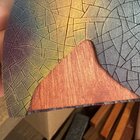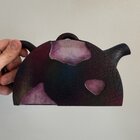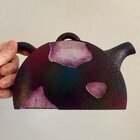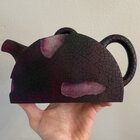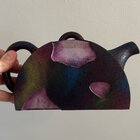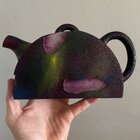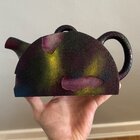I added quite a few more thin layers of paint, but for the sake of not ruing the surprise, I won't post those photos. Following the conclusion of my paint, I used a chisel to clean up any burn lines that were filled with paint (this took a while), and then I sprayed several coats of semi-gloss lacquer (from a rattle can, nothing fancy, though I am planning to get an HVLP setup soon). This is where my first big d'oh! moment happened. Rule of thumb is that fresh lacquer and adhesive don't mix. Rather, fresh lacquer sort of melts the adhesive. Because of this oversight, when I removed my masking tape from the recessed areas, there was so much fine adhesive reside left over. Oh my gosh, I had a mini-panic moment because I obviously had to clean it up, and I had to do it in a way that wouldn't harm my paint/lacquer.
Fortunately, an easy way to clean up adhesive reside is with oil, and I had previously oiled my wood. I simply added some more oil (hemp oil in this case), to the recessed areas, let it sit for a while, and then rubbed them clean with a paper towel. Residue erased--whew!
My other d'oh! moment was when I went to spray lacquer on my lid cavity and collar/insert. I didn't mention this, but I used India ink to blacken the interior of the teapot, collar/insert, and lid cavity and underside. I masked off the entrance to my teapot interior with blue painter's tape, as well as put tape over the wooden recesses just to prevent overspray (keep in mind this is after I sprayed my final coats of lacquer):

After I sprayed the lacquer, I was left with a couple issue. The minor issue was that the tape on top dulled the semi-gloss, so that that you could see an outline of the paint. No big issue there--I simply lightly rubbed the top with a grey scothbrite pad, cut out some paper masks to protect the wooden recess on top, and then sprayed another coat of lacquer. Fixed!
The bigger problem was that when I removed the tape from the sides of the teapot, a couple of areas (at the border of the recesses) of lacquer/paint adhered to the tape and I was left with black spots.

What to do? Well, I got a bunch of paint back out, did a bunch of mixing, and spot fixed the area that needed repair.
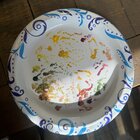
Super tedious, albeit somewhat enjoyable, and the results looked okay. Not perfect, but good enough to be satisfied (and more importantly, good enough to not look like a fix). Here is a shot before I added the final layering touches to one of the fixes.
